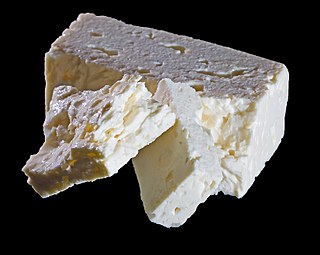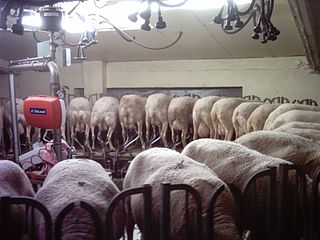
Feta is a Greek brined white cheese made from sheep's milk or from a mixture of sheep and goat's milk. It is soft, with small or no holes, a compact touch, few cuts, and no skin. Crumbly with a slightly grainy texture, it is formed into large blocks and aged in brine. Its flavor is tangy and salty, ranging from mild to sharp. Feta is used as a table cheese, in salads such as Greek salad, and in pastries, notably the phyllo-based Greek dishes spanakopita "spinach pie" and tyropita "cheese pie". It is often served with olive oil or olives, and sprinkled with aromatic herbs such as oregano. It can also be served cooked, as part of a sandwich, in omelettes, and many other dishes.

Three European Union schemes of geographical indications and traditional specialties, known as protected designation of origin (PDO), protected geographical indication (PGI), and traditional speciality guaranteed (TSG), promote and protect names of agricultural products and foodstuffs. Products registered under one of the three schemes may be marked with the logo for that scheme to help identify those products. The schemes are based on the legal framework provided by the EU Regulation No 1151/2012 of the European Parliament and of the Council of 21 November 2012 on quality schemes for agricultural products and foodstuffs. This regulation applies within the EU as well as in Northern Ireland. Protection of the registered products is gradually expanded internationally via bilateral agreements between the EU and non-EU countries. It ensures that only products genuinely originating in that region are allowed to be identified as such in commerce. The legislation first came into force in 1992. The purpose of the law is to protect the reputation of the regional foods, promote rural and agricultural activity, help producers obtain a premium price for their authentic products, and eliminate the unfair competition and misleading of consumers by non-genuine products, which may be of inferior quality or of different flavour. Critics argue that many of the names, sought for protection by the EU, have become commonplace in trade and should not be protected.

Goat cheese, goat's cheese or chèvre is cheese made from goat's milk. Goats were among the first animals to be domesticated for producing food. Goat cheese is made around the world with a variety of recipes, giving many different styles of cheeses, from fresh and soft to aged and hard.

Podhale, sometimes referred to as the Polish Highlands, is Poland's southernmost region. The Podhale is located in the foothills of the Tatra range of the Carpathian mountains. It is the most famous region of the Goral Lands which are a network of historical regions inhabited by Gorals.

Bryndza or brynza is a sheep milk cheese made across much of East-Central Europe, including in Ukraine and Slovakia. Bryndza cheese is creamy white in appearance, known for its characteristic strong smell and taste. The cheese is white, tangy, crumbly and slightly moist. It has characteristic odor and flavor with a notable taste of butyric acid. The overall flavor sensation begins slightly mild, then goes strong and finally fades to a salty finish. Recipes differ slightly across countries.

Sirene, also known as "white brine sirene", is a type of brined cheese originating from Bulgaria. It is made of the milk of goat's, sheep's, cow's, buffalo's or a mixture thereof. It is slightly crumbly, with at least 46–48% of dry matter containing 44–48% of fat. It is commonly produced in blocks, and has a slightly grainy texture. It is used as a table cheese, in salads, and in baking.
Žinčica, Žinčice, Żętyca, Жентиця, or Zyntyca is a drink made of sheep milk whey similar to kefir consumed mostly in Slovakia and Poland. It is a by-product in the process of making bryndza cheese.

Pag cheese or Pag Island cheese is a Croatian variety of hard, distinctively flavored sheep milk cheese originating from the Adriatic island of Pag. It is generally regarded as the most famous of all artisan cheeses made in the country and can be found in many markets outside Croatia.

Oštiepok is a traditional smoked sheep milk cheese made in Slovakia. Oštiepok is a protected trade name under the EU's protected geographical indication.

Oscypek, rarely Oszczypek, is a smoked cheese made of salted sheep milk exclusively in the Tatra Mountains region of Poland. Oscypek is made by an expert named "baca", a term also denoting a shepherd in the mountains. The cheese is a traditional holiday cheese in some European countries and is often pan fried and served with cranberry jam (żurawina) on the side.

Oltermanni is a brand of Finnish cheese somewhat similar to the Danish cheese Havarti. It is often eaten on rye bread, or with other dishes. Oltermanni is manufactured by Valio. The cheese is less salty than others.

Koryciński, also known as "Swojski" (homemade), is a hard cheese made from cow's milk, named after the village of Korycin in Poland, and made in the Podlaskie Voivodeship in eastern Poland. In the traditional technique of producing the cheese, dried and powderized veal stomachs were used as rennet. The cheese takes the form of a flattened ball with a diameter of 30 cm and weight of 3 kg. Normally, around 25 litres of milk are used to produce it. It is considered to be the oldest Polish cheese. Currently, different varieties of the cheese are produced, most notably the ones with herbs and garlic added as ingredients.

Sheep's milk is the milk of domestic sheep. It is commonly used to make cultured dairy products, such as cheese. Some of the most popular sheep cheeses include feta (Greece), ricotta (Italy), Roquefort (France) and Oscypek (Poland).
Bryndza Podhalańska is a Polish variety of the soft cheese Bryndza, from the Podhale region, it is made from sheep's milk.

Redykołka is a type of cheese produced in the Podhale region of Poland. It is sometimes known as the "younger sister" of the Oscypek cheese and the two are occasionally confused. The similarity comes from the fact that redykołka is traditionally made using leftover Bundz from Oscypek production.

Sheep milk cheese is a cheese prepared from sheep milk. Well-known cheeses made from sheep milk include the feta of Greece, Roquefort of France, manchego from Spain, the pecorino romano and ricotta of Italy. Yogurts, especially some forms of strained yogurt, may also be made from sheep milk.














